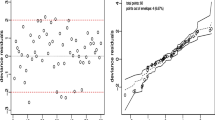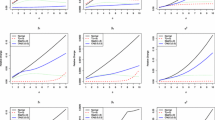Abstract
Censored data are quite common in statistics and have been studied in depth in the last years [for some references, see Powell (J Econom 25(3):303–325, 1984), Murphy et al. (Math Methods Stat 8(3):407–425, 1999), Chay and Powell (J Econ Perspect 15(4):29–42, 2001)]. In this paper, we consider censored high-dimensional data. High-dimensional models are in some way more complex than their low-dimensional versions, therefore some different techniques are required. For the linear case, appropriate estimators based on penalised regression have been developed in the last years [see for example Bickel et al. (Ann Stat 37(4):1705–1732, 2009), Koltchinskii (Bernoulli 15:799–828, 2009)]. In particular, in sparse contexts, the \(l_1\)-penalised regression (also known as LASSO) [see Tibshirani (J R Stat Soc Ser B 58:267–288, 1996), Bühlmann and van de Geer (Statistics for high-dimensional data. Springer, Heidelberg, 2011) and reference therein] performs very well. Only few theoretical work was done to analyse censored linear models in a high-dimensional context. We therefore consider a high-dimensional censored linear model, where the response variable is left censored. We propose a new estimator, which aims to work with high-dimensional linear censored data. Theoretical non-asymptotic oracle inequalities are derived.

Similar content being viewed by others
References
Belloni A, Chernozhukov V (2011) \(\ell _1\)-Penalized quantile regression in high-dimensional sparse models. Ann Stat 39(1):82–130
Bickel PJ, Ritov Y, Tsybakov AB (2009) Simultaneous analysis of lasso and dantzig selector. Ann Stat 37(4):1705–1732
Bühlmann P, van de Geer S (2011) Statistics for high-dimensional data. Springer, Heidelberg
Candes E, Tao T (2007) The dantzig selector: statistical estimation when p is much larger than n. Ann Stat 35:2313–2351
Chay KY, Powell JL (2001) Semiparametric censored regression models. J Econ Perspect 15(4):29–42
Fan J, Li R (2001) Variable selection via nonconcave penalized likelihood and its oracle properties. J Am Stat Assoc 96(456):1348–1360
Friedman J, Hastie T, Tibshirani R (2008) Sparse inverse covariance estimation with the graphical lasso. Biostatistics 9(3):432–441
Koltchinskii V (2009) The Dantzig selector and sparsity oracle inequalities. Bernoulli 15:799–828
Koltchinskii V (2011) Oracle inequalities in empirical risk minimization and sparse recovery problems: École dÉté de Probabilités de Saint-Flour XXXVIII-2008, vol 2033. Springer, Berlin
Li Y, Zhu J (2008) L1-Norm quantile regression. J Comput Graph Stat 17(1):163–185
Murphy SA, van der Vaart AW, Wellner JA (1999) Current status regression. Math Methods Stat 8(3):407–425
Powell JL (1984) Least absolute deviations estimation for the censored regression model. J Econom 25(3):303–325
Städler N, Bühlmann P, van de Geer S (2010) \(l_1\)-Penalization for mixture regression models. Test 19:209–285
Tibshirani R (1996) Regression shrinkage and selection via the lasso. J R Stat Soc Ser B 58:267–288
van de Geer S (2000) Empirical processes in M-estimation. Cambridge University Press, Cambridge
van de Geer S (2003) Adaptive quantile regression. In: Akritas MG, Politis DN (eds) Recent trends in nonparametric statistics. Elsevier Science, Amsterdam, pp 235–250
van de Geer S (2007) The deterministic Lasso. In: JSM Proceedings, 2007, vol 140. American Statistical Association
van de Geer S (2008) High-dimensional generalized linear model and the Lasso. Ann Stat 32(2):614–645
van de Geer S, Bühlmann P (2009) On the conditions used to prove oracle results for the Lasso. Electron J Stat 3:1360–1392
Yuan M, Lin Y (2006) Model selection and estimation in regression with grouped variables. J R Stat Soc: Ser B (Stat Methodol) 68(1):49–67
Zou H (2006) The adaptive lasso and its oracle properties. J Am Stat Assoc 101(476):1418–1429
Zou H, Hastie T (2005) Regularization and variable selection via the elastic net. J R Stat Soc Ser B 67:301–320
Author information
Authors and Affiliations
Corresponding author
Rights and permissions
About this article
Cite this article
Müller, P., van de Geer, S. Censored linear model in high dimensions. TEST 25, 75–92 (2016). https://doi.org/10.1007/s11749-015-0441-7
Received:
Accepted:
Published:
Issue Date:
DOI: https://doi.org/10.1007/s11749-015-0441-7
Keywords
- Lasso with censored data
- High-dimensional censored model
- Censored \(L_1\)-regularisation
- Penalised regression with censored data




